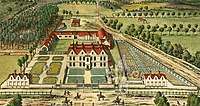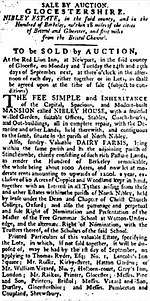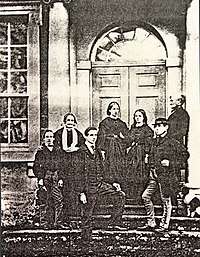Nibley House, North Nibley
Nibley House, North Nibley in Gloucestershire is a house of historical significance and is Grade II* listed on the English Heritage Register.[1] The Neoclassical Georgian facade dates from 1763 behind which lies the Jacobean manor house built in 1609 by John Smythe the Elder, Steward at the time to Lord Berkeley. It was the home of many notable people over the next four centuries. Today it is still a private residence which provides bed and breakfast and camping accommodation and is also a wedding venue.[2]
.jpg)
Early residents

John Smyth (1567-1640) built the Jacobean part of Nibley House in 1609. He is a notable historical figure as he was the steward and biographer of the Berkeley family who were large landowners.[3] The numerous books that he wrote are highly regarded by current historians and widely quoted as they accurately portray social conditions of that time.

He was married twice. Shortly after his second marriage in 1609 to Mary daughter of John Browning of Cowley he built Nibley House. The couple had five sons and three daughters. He acquired a large amount of property which was listed in his Will of 1640. The Will can be read at this reference.[4]
Nibley House was inherited by his son John Smyth Jnr. (1611-1692). He also wrote books, the most notable being “A Description of the Hundred of Berkeley”. In 1631 he married Anne, the daughter of Sir Edward Bromfield, Mayor of London. She died in 1643 and was buried at North Nibley. Soon after he married her cousin also called Anne Bromfield. Altogether John Smyth Jnr. fathered sixteen children.
From about 1640 John was reluctantly caught up in the Civil War and a full account of his involvement can be read at this reference.[5] John’s eldest son was Edward who had married Rose, daughter of Sir Edward Leech (MP) or Leche of Shipley Hall. However John was convinced that these two were very extravagant so he left his estate in North Nibley to his grandson George Smyth (1665-1712). It was settled on him at the time of his marriage in 1691 to Dorothy Mann of Norwich.[6] He later married Margaret, daughter of Charles Dowdeswell of Forthampton.[7] In the early 1700s George had a coloured engraving made if his estate which can be seen here.[8]
His son George Smyth (1712-1771) was born shortly after his father died in 1712. In his will his father mentions that his wife Margaret is pregnant and he leaves all of his estates to this child whether it is a son or daughter.[9]
George Smyth (1712-1771) is the one who in 1763 made major alterations and additions to the Jacobean house and transformed it into house that can be seen today.[10] In 1735 he married Sarah, the daughter of Henry Biggs of Benthall.[11] The couple had three sons and a daughter. After he died in 1771 Nibley House was passed to his son Nicholas Smyth. In 1767 Nicholas married Anna Maria, the daughter of Sir Charles Leighton who was the heiress to her grandmother’s Condover Estates. They had one son Nicholas Owen Smyth born in 1769. He inherited Nibley House on the death of his father in 1790 and as he was living at Condover he sold it. The advertisement for the sale in 1798 is shown.
Later residents
The house was sold to John Jortin (1773-1843). He was an attorney of Lincoln's Inn and a very large landowner. In 1801 he married Sarah Bearpacker, daughter of Edward Bearpacker of Wotton-under-Edge.[12] They had one son John but unfortunately he died in 1827 at the age of 13. His wife Sarah died in 1840 and in 1842 he married Ann Catherine Whitelock of Bath. He died in 1843 and Ann Catherine died in 1875. There are monuments in St Martin’s Church, North Nibley to all four of these people.[13] As his only son had died John Jortin left Nibley House to a distant relative William Lee on condition that he add the surname Jortin to his own name.[14]
William Lee Jortin (1809-1861) lived at the house for several years and then in about 1848 sold it to the Bennett family who are shown to be the residents in the 1851 Census. This family lived there for the next fifty years[15] and in about 1884 changed the name from Nibley House” to “The Great House”.

Isaac Bennett (1801-1872) was born in 1801. His father was Joseph Bennett who owned Grange Farm in Kingswood near Wotton-under-Edge. In 1833 he married Anne Knight (1810-1879). The couple had five sons and two daughters. He farmed the 200 acres surrounding the house for about 20 years and then in about 1870 he moved to a cottage on the estate and his son Charles moved into Nibley House and took over the running of the farm.
Charles Bennett (1839-1879) was born in 1839 in Kingswood. In 1871 he married Louisa Daw (1839-1923). They had two sons and two daughters. Unfortunately Charles died in 1879 leaving Louisa to care for four children under six years of age. However the 1881 Census shows that she became the head of Nibley House and continued running the estate. She lived there until 1901 when she sold the property to Colonel Noel.[16]
Colonel William Frederick Noel (1849-1923) was born in 1849. He was the son of Colonel Edward Andrew Noel. He married three times and had five children but he was divorced once and his two other wives died before 1900.[17] Therefore when he moved into Nibley House he was a widower. The 1911 Census reveals him living there with his two daughters, a governess, a cook, a ladies maid, two housemaids, a kitchen maid and a page. In the same year he sold the house to Lieutenant Colonel Buckton and moved to Newent.[18]
Lieutenant Colonel James Douglas Buckton (1861-1933) was born in 1861 in Mold, Flintshire. His father was James Rhoades Buckton was an attorney in Hoole. James also became an attorney. In 1896 he married Elizabeth Appleton (1882-1940) who was the daughter of the Reverend Richard Appleton of Louth. The couple had no children. For many years he commandeered Company A of the Prince of Wales Battalion in Lancashire. He was also a Justice of the Peace for Lancashire and Gloucestershire.[19] When he died in 1933 he had a military funeral at North Nibley Church which was described in the newspapers.[20] He left his estate to his wife Elizabeth during her lifetime and then after that to the parish church of St Mary in Mold, Wales. Elizabeth died in 1940 and the Church sold the property in 1941 to the Eley family who still own it today.
References
- English Heritage Register. Online reference
- Nibley House website. Online reference
- Dictionary of National Biography. Online reference
- Gray, I. E,, “Smith of Nibley’s Will” Transactions of the Bristol and Gloucestershire Archaeological Society, Vol. 78, 1959, pp. 129-136. Online reference
- Howes, R. “John Smyth the Younger of North Nibley and His Papers”, Transactions of the Bristol and Gloucestershire Archaeological Society, Vol 121, 2003, pp. 213-231. Online reference
- Howes, R. “John Smyth the Younger of North Nibley and His Papers”, Transactions of the Bristol and Gloucestershire Archaeological Society, Vol 121, 2003, p. 223. Online reference
- “The Berkeley manuscripts”. Online reference
- Johannes Kip State of Gloucestershire Antique Prints 1712. https://panteek.com/Johanneskip3/pages/kip500.htm Online reference]
- Prerogative Court of Canterbury and Related Probate Jurisdictions: Will Registers; Class: PROB 11; Piece: 532
- Samuel Rudder 1779 “A New History of Gloucestershire”, p. 575. Online reference
- Transactions of the Shropshire Archaeological and Natural History Society, Ser. 4. Vol. 6, 1916, p. 282. Online reference
- The Gentleman’s Magazine, 1801, p. 1148. Online reference
- Monumental Inscriptions in North Nibley. Online reference
- The Gentleman's Magazine, Volumes 176-177, 1844. Online reference
- England Census of 1861, 1871, 1881, 1891, 1901.
- Gloucestershire Chronicle - Saturday 28 September 1901, p. 4.
- The Peerage website http://www.thepeerage.com/p29827.htm#i298266
- Cheltenham Chronicle - Saturday 03 June 1911, p. 3.
- Western Daily Press - Wednesday 28 June 1933, p. 8.
- Western Daily Press - Wednesday 28 June 1933, p. 8